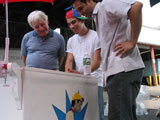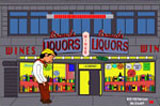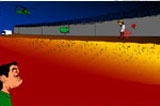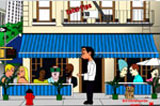 Ricardo
Miranda Zuņiga is a digital
artist with a penchant for interactive displays and politically charged
computer games. Drawing from a variety of cultural influences, Zuņiga
creates art with the ability to provoke as well as to entertain. His
website hosts a whole load of fascinating projects, many of which users
can access and interact with via their web browser. We were fortunate to
spend a bit of time discussing Zuņiga’s latest project,
Vagamundo: A Migrant’s Tale.
Ricardo
Miranda Zuņiga is a digital
artist with a penchant for interactive displays and politically charged
computer games. Drawing from a variety of cultural influences, Zuņiga
creates art with the ability to provoke as well as to entertain. His
website hosts a whole load of fascinating projects, many of which users
can access and interact with via their web browser. We were fortunate to
spend a bit of time discussing Zuņiga’s latest project,
Vagamundo: A Migrant’s Tale.
GamesFirst!: For our readers, could you give us a bit of
background on yourself?
Ricardo Miranda Zuņiga: I grew up between Nicaragua, the country
that both my parents are from where I spent my childhood summers, and
San Francisco, the city to which my parents immigrated. Although my
formal education has been within the borders of the United States, my
personal perspectives and ideology have been molded by a bicultural
reality, consisting of such polar elements as Disneyland and the
Nicaraguan Leftist Revolutionary movement, led by the Sandinistas. I
attended UC Berkeley for undergrad doing a double in English Literature
and Practice of Art and a minor in Spanish Literature. I came to art
late during undergrad, my junior year, so following undergrad I stayed
in Oakland, CA where I had a studio and focused on painting and film.
After one year I went to Mexico City, lived there for half a year and
then onto Nicaragua where I helped an uncle start a poultry farm. I then
returned to the States to attend grad school at Carnegie Mellon
University. I completed my MFA in 99 and have been teaching and making
work since.
GF!: Could you describe Vagamundo--its physical incarnation as
well as the game?
 RMZ:
Vagamundo is a mobile public art project designed for on the street
interaction to create temporary public commons. Through a mobile cart
resembling an ice cream cart pedestrians are invited to play a video
game that reflects the plight of illegal immigrants in New York.
RMZ:
Vagamundo is a mobile public art project designed for on the street
interaction to create temporary public commons. Through a mobile cart
resembling an ice cream cart pedestrians are invited to play a video
game that reflects the plight of illegal immigrants in New York.
In the United States, there are currently over eight million illegal
immigrants, including more than three million from Mexico. The majority
of these immigrants compose a near slave labor population contributing
to the U.S. economy. Meanwhile the U.S. Government has spent over twelve
billion dollars since 1992 to deter immigration along the southern
border by implementing operations Gatekeeper in California, Safeguard in
Arizona and Rio Grande in Texas.
Since 9/11, the Bush administration has added 100 million dollars to
border patrol, increasing the annual tab to 2.5 billion dollars. However
the number of people crossing the border has not decreased, though the
number of mortalities along the trek across the border has increased,
and perhaps this is the point.
People desperately seeking to escape poverty will not be deterred by
border patrol; they will merely be forced to risk much more dangerous
and isolated paths through canals, deserts and mountains. In June of
2002, 70 people died crossing the border according to Mexican records
and 62 according to U.S. records.
 The
fortunate people that successfully make it through the border and into a
community face the daunting task of entering into the U.S. economy while
struggling against such factors as being undocumented, not speaking
English, and racism and discrimination. Many who cannot find a means
into the mainstream economy must create an alternate means of
sustenance.
The
fortunate people that successfully make it through the border and into a
community face the daunting task of entering into the U.S. economy while
struggling against such factors as being undocumented, not speaking
English, and racism and discrimination. Many who cannot find a means
into the mainstream economy must create an alternate means of
sustenance.
On a summer's day walk in East Williamsburg and other parts of
Brooklyn, you will encounter street food vendors who have constructed
their own carts and sell home cooked foods such as tamales. These people
represent an alternate economy. In all major cities today you are likely
to find paleteros, vendors of ice cream bars, a relatively new immigrant
based business in many cities--a business far more common in Latin
American developing countries, but now increasing in the United States,
as the Third World tactics of survival grow within the U.S.
The project is informed by interviews that I conducted with new
immigrants from Latin America residing in Manhattan and Brooklyn as well
as years of working as a busboy in San Francisco and my parent's own
plight. The game, that is a computer, monitor and joystick are placed
within a hand built cart that sits on two back tires and a front caster.
The use of the hand built ice cream cart establishes a concrete
association with the thousands of paleteros found in major U.S. cities
pushing their carts and selling various flavors of crushed ice for a
dollar through hot summer days.
The game is composed of three levels; each level represents a move up
in the social scale and assimilation to the United States. The player
controls the main character of the game, Cantinflas, the famous Mexican
comedian of the Golden Age of Mexican Cinema; an iconic figure not
unlike Charlie Chaplin. In each level, Cantinflas must overcome an
obstacle to continue ahead:
Level 1: El Borracho, represents a "Culture of Poverty" as an outcome
of cultural traits such as bad work habits, heavy drinking, and
violence. The player must avoid the flying liquor bottles to earn a job.
 Level 2:
The Green Grocer Bagger represents a "Culture of Assimilation." In the
second level, the player acquires a job at a corner grocery as a bagger
and florist, jobs favored by new immigrants, because it allows them to
begin learning English. However in the game, the player must fight and
beat the stereotype monster, a giant cockroach.
Level 2:
The Green Grocer Bagger represents a "Culture of Assimilation." In the
second level, the player acquires a job at a corner grocery as a bagger
and florist, jobs favored by new immigrants, because it allows them to
begin learning English. However in the game, the player must fight and
beat the stereotype monster, a giant cockroach.
Level 3: The Head Waiter represents a "Culture of Prosperity." The
player has learned English and is now a waiter at an upscale restaurant
in the Upper East Side. Cantinflas must keep the guests happy and earn
$200 in tips to beat the game.
Extra Level: Once the player has won the game, s/he is offered the
choice to discriminate against new immigrants or two help new
immigrants. If the player selects to discriminate, s/he is awarded an
extra level as border patrol, where one may fire at illegal immigrants.
If the player selects to help, s/he is awarded a list of informative
books and contact information to nonprofit organizations dedicated to
helping new immigrants.
GF!: What is your goal with Vagamundo? What should people get
from it?
RMZ: Ideally, the project achieves two goals. First to present an
interesting tableau that interrupts the given codes of public space as
an unsuspecting pedestrian discovers a free videogame in an ice cream
cart. And second, Vagamundo places the player in the role of a new,
undocumented immigrant to New York City, an experience that may cause
one to consider what life is like for others. The "others" that the
project concerns itself with is an impoverished immigrant subculture
that goes highly unnoticed by mainstream media; a subculture that only
receives news coverage in events of disaster, such as the death of
seventeen individuals due to asphyxiation in the back of a truck after
paying $2000 each to be taken across the border. Hence the project
doesn't seek to create a positive image of how far Hispanics have come
in the United States--that is the cosmetic image that mainstream media
does choose to represent. Rather, I seek to put the viewer/player in a
game that will have her/him reflect upon the intense hardships of
undocumented immigrants during the journey across the border as well as
part of our labor force once here in the United States. I target
upper-middle class and upscale neighborhoods, as well as areas where
broadly mixed cultures intersect.
GF!: Why did you create this piece as a game? What do the game
qualities add to the artwork?
 RMZ:
I'm enamored by street carts of all sorts, I have an earlier project
titled Cargo Load that was a sculptural cart designed for public
performance, I think of this piece as a predecessor. Originally,
Vagamundo was to be a cart resembling a street food cart, but presenting
two single channel videos composed of interviews with food vendors in
Brooklyn and Manhattan. I was taken by the difference between the
un-incorporated vendors in Brooklyn, many without a license versus the
fully incorporated and licensed vendors in Manhattan. As I interviewed
them, I realized that nearly all of them were new immigrants. I also
began to realize that the interviews were not all that interesting. As I
spoke to more people, I began to move away from the video, though I
don't recall how exactly it became a video game. I realized that I
wanted viewers to focus on one screen rather than two and I wanted the
piece to be interactive in some way.
RMZ:
I'm enamored by street carts of all sorts, I have an earlier project
titled Cargo Load that was a sculptural cart designed for public
performance, I think of this piece as a predecessor. Originally,
Vagamundo was to be a cart resembling a street food cart, but presenting
two single channel videos composed of interviews with food vendors in
Brooklyn and Manhattan. I was taken by the difference between the
un-incorporated vendors in Brooklyn, many without a license versus the
fully incorporated and licensed vendors in Manhattan. As I interviewed
them, I realized that nearly all of them were new immigrants. I also
began to realize that the interviews were not all that interesting. As I
spoke to more people, I began to move away from the video, though I
don't recall how exactly it became a video game. I realized that I
wanted viewers to focus on one screen rather than two and I wanted the
piece to be interactive in some way.
GF!: Do you play games for fun or inspiration? Which are your
favorites?
RMZ: I grew up playing games; though I missed the first
generation in my age group which is the ATARI 2600, my brother and I
were able to convince our parents to purchase Intellivision, soon came
after ATARI and with a more complex interface and higher end graphics. I
loved playing Utopia, Night Stalker and the like. After school I usually
headed to the arcades to play Ms Pac Man, Donkey Kong... Today, however,
I rarely get a chance to play, though I have spent some time with
on-line gaming. I really can't name a favorite these days, since it's so
seldom that I play. Which is probably why I modeled Vagamundo after the
first Street Fighter game--single perspective.
GF!: Could you tell us a little about the reactions you get to
Vagamundo on the street? What do people say? What kind of people engage
with it?
 RMZ:
Generally adults shy away from it, but kids anywhere from 4 yrs old to
15 are immediately drawn to it. My experience has been that the kids
over the age of 9 grasp the content and can even discuss it with me. The
younger kids are just taken by the animation and interaction.
RMZ:
Generally adults shy away from it, but kids anywhere from 4 yrs old to
15 are immediately drawn to it. My experience has been that the kids
over the age of 9 grasp the content and can even discuss it with me. The
younger kids are just taken by the animation and interaction.
Adults will stand around, watch someone younger play it. They may ask
questions, but generally will not play unless they are prodded. And even
then they say over and over how bad they are at video games. So i may
very well be using the wrong medium for the people that i seek to
target.
I presented the cart at a street festival last fall; it was The
Kitchen's annual neighborhood fair, and there were live theater
performances, puppet performances all sorts of great stuff. However
there were a large number of kids that were drawn to the game and had to
be dragged away by their parents, and if they got a chance to escape,
they would come right back. All this left me feeling horribly, because I
had introduced to a great street fair just the sort of thing that
parents are trying to get their kids away from. It also led me to
consider that i must investigate non-screen based interaction. I'm
currently working on a project that you may find interesting:
http://www.ambriente.com/wifi/ It's a whole different dynamic, but
should be fun, if I get it all working. It is expected to be part of an
event in July. An interesting interaction was one girl who really wanted
crushed ice. She asked me what flavors I had and I told her none, but
invited her to play the game. She was visibly annoyed and walked away
without a word. She later came back with a cone of ice, pushed her way
to the front and played while getting sugar water all over the cart.
And the first time I presented the cart, a soccer team of 9 year olds
tore the joystick off in the first half hour. The joystick remains a bit
of a problem, since I haven't found an industrial USB gamepad or
joystick and I don't want to keep replacing it.
You can visit Ricardo Miranda Zuņiga’s website at
www.ambriente.com,
and we recommend you do.
